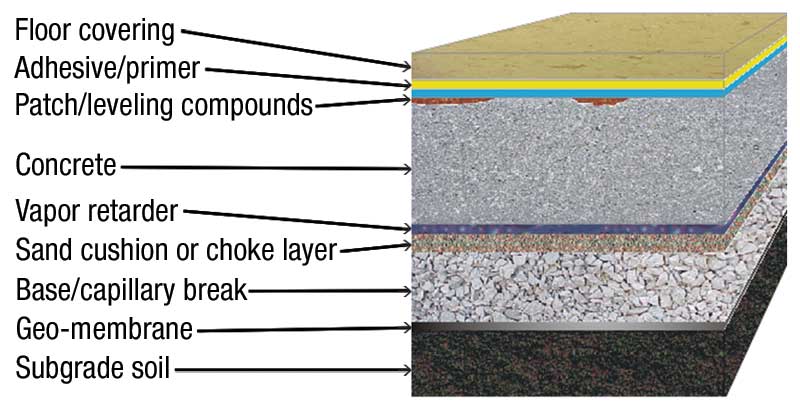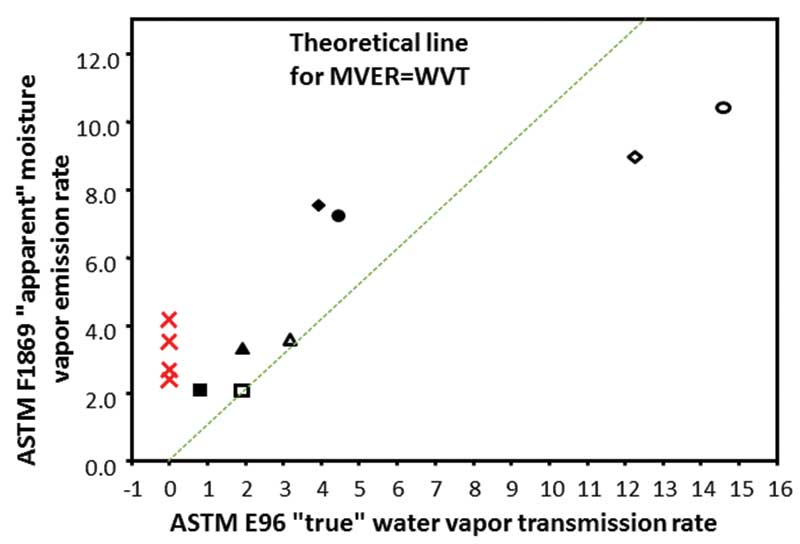Moisture measurement in concrete floor slabs
by Katie Daniel | December 9, 2016 10:45 am

by Jason Spangler
Moisture presence in concrete slabs can cause problems for all types of floors, including carpeting, wood, stone, poured polymeric, and resilient finish. Too much moisture can cause floorcoverings to cup, buckle, blister, and discolor, and these problems can occur days, months, or years after installation. In other words, excess moisture adversely affects the assembly’s short- and long-term viability. It can also affect any type of project, whether commercial, residential, or industrial. Specification of a reliable, accurate moisture measurement method is vitally important for ensuring a successful outcome.
Concrete is said to ‘breathe’ with the environment—that is, it allows moisture to move in and out of the slab, depending on the ambient conditions. When evaluating a problem, it is therefore necessary to understand the moisture condition inside the concrete and not just at the surface. Unfortunately, the latter is historically where most moisture testing has been done.
Moisture can be found in slabs above grade. These can be elevated structural slabs or concrete in steel decks, such as a building that is framed in corrugated or ribbed steel sheets supporting the concrete floor (Figure 1). Not only do these slabs have construction water that needs to evaporate, but they can also be impacted by the ambient relative humidity (RH) in the room. On hot, humid days, moisture goes into the concrete; on drier days, it comes out. Rain, snow, or fog can also get onto the slab.
In slabs below grade, moisture comes in the form of sub-slab vapor. This is the predominant cause of moisture problems—the culprit is not liquid water below the floor that gets in contact with the slab from the underside, but rather moisture vapor in the soil that comes up into the slab. This is the primary reason for needing a sub-slab vapor retarder.
 [1]
[1]Image courtesy CTLGroup and Wagner Meters
In the slab itself is the batch water (the ratio of water to cement that was originally batched into the concrete), which includes ‘water of convenience’ to make concrete placing and finishing easier. This is one of the main factors determining how long it takes a concrete floor to dry.
Most floors are poured on grade (i.e. slabs-on-ground), which means the concrete slab’s surface is the primary way for the moisture within to escape. As moisture evaporates through the surface, the moisture deeper in the slab moves toward the surface. This creates a moisture gradient that is drier on the surface and wetter toward the bottom.
Moisture equilibrium: Why is it important?
When flooring is installed over the slab, this essentially creates a seal so moisture can no longer escape from the surface. Over time, the moisture condition throughout the slab tends to equalize, creating what is called a ‘moisture equilibrium.’ This point equates to the true, long-term moisture condition of the slab; it is a critical factor in determining the installed floor’s long-term viability. Knowing this, it is important to specify a measurement method that can reliably and accurately indicate the moisture condition at the point of equilibrium.
The two measurement methods most commonly used in the United States are:
- the calcium chloride (CaCl2) test, which is standardized as ASTM F1869, Standard Test Method for Measuring Moisture Vapor Emission Rate of Concrete Subfloor Using Anhydrous Calcium Chloride; and
- the in-situ RH test, which is standardized as ASTM F2170, Standard Test Method for Determining Relative Humidity in Concrete Floor Slabs Using In-situ Probes.
However, only the latter of these can be relied on for consistent, accurate test results closely related to the critically important point of moisture equilibrium.
Scientific studies in recent decades have shown the slab’s moisture condition (and how it affects installed flooring) can best be measured by looking at the RH deep down in the concrete with a probe set into the floor slab. Since 2002, the in-situ RH moisture test, as described in ASTM F2170, has been increasingly favored over ASTM F1869 as the ‘gold standard’ for moisture testing.
| TESTING CONCRETE ALKALINITY |
| It is useful to keep in mind the moisture condition of the concrete slab is closely tied to pH—a measure of hydrogen ion concentration. This can be assessed quite simply using a pH meter.
When moisture is not an issue, pH should not be one either. Still, given highly alkaline conditions will typically lead to de-bonding and other serious flooring issues, it is generally good practice to test the pH, and many flooring manufacturers require it. |
Why using the moisture vapor emission rate test can be risky
The ASTM F1869 test does not give reliably accurate results because it is based on a faulty premise: namely that testing moisture at the concrete slab surface—where the CaCl2 crystals are placed—reflects the overall slab’s true moisture condition.
Several factors make surface moisture test results misleading. For example, ambient conditions can interfere with test results. Warmer or more humid room air can lead to higher test numbers, while colder or less humid air in the room can lead to lower test numbers. In either case, the test result may not reflect the actual moisture condition within the slab.
Further, the test measures the moisture level only at the top 12 to 18 mm (1⁄2 to 3⁄4 in.) of the concrete slab. Since moisture leaves through the top of the concrete, this uppermost layer is typically drier than conditions deeper within the slab.
Conversely, CaCl2 crystals can also attract a disproportionate amount of moisture from the concrete, making it seem like the slab has more moisture than it really does. This false result can then unnecessarily delay the floor installation.
Results only indicate the moisture condition at the top of the concrete slab at the time of the test, not the slab’s eventual point of moisture equilibrium. It is the moisture associated with this equilibrium that is the most useful indicator of whether the installed flooring will remain functional or buckle, crack, or suffer from other serious defects.
Engineers and inspectors in the United States first used the CaCl2 test—called the ‘dampness test’—as early as 1941. It involved placing a dish of CaCl2 crystals under a sealed glass dome and returning the next day to examine for dampness. This ‘eyeball’ qualitative assessment was employed for years without any studies to support its use, or the size and shape of the dish and dome. It was strictly a qualitative ‘go or no-go’ test without any associated numerical result.
Over the years, attempts have been made to quantify the test. Today, one measures the crystals and expresses the test result in terms of pounds of moisture per 1000 square feet for 24 hours, termed the moisture vapor emission rate (MVER). However, nothing in the scientific literature specifically points to a reliably safe threshold for application of adhesives or floorcoverings, whether 2 or 3 lb per 1000 sf in 24 hours, or some other threshold.
 [2]
[2]Image courtesy CTLGroup
Studying the MVER or CaCl2 test
To test the CaCl2 method more thoroughly, CTLGroup (a research body and subsidiary of the Portland Cement Association [PCA]) carried out a long-term study mimicking the test conditions.
Figure 2 shows some of the study’s results, comparing outcomes using the CaCl2 test to actual MVER. The diagonal line is a 1:1 ratio representing the line of accuracy for the test. Most points fall considerably far off the line, demonstrating the test is not particularly accurate. There is a tendency toward high test numbers at lower moisture levels, and low test numbers at higher moisture levels.
In addition, the four red Xs on the graph represent four concrete slabs that actually sat in the room at 50 percent humidity for several years. When they were weighed day after day, after several years, they were neither emitting moisture nor gaining moisture, and had a very low moisture level. However, when measured according to ASTM F1869, the results ranged from 2.5 to more than 4 lb. The desiccant in the CaCl2 kit was actually sucking out more moisture than was coming out of the concrete, giving a false positive result.

Photo courtesy Davis Colors
Other methods of testing concrete moisture conditions
Other ways of measuring moisture in concrete, though less commonly used than the CaCl2 test method, also reveal significant inadequacies.
Plastic sheet test
In ASTM D4263, Standard Test Method for Indicating Moisture in Concrete by the Plastic Sheet Method, a 460-mm (18-in.) square of plastic is taped onto the floor to see if moisture droplets form underneath. The test depends on the slab’s surface temperature and the concrete’s dewpoint. If moisture is seen under the plastic sheet, it is accepted the moisture level in the slab is too high. However, when moisture does not develop, it does not mean the moisture level in the concrete is acceptable.
Mat bond test
This test uses a 1-m (3-ft) square of flooring adhered to the concrete slab to evaluate the bond. However, in real jobsite conditions, the test usually cannot be left in place long enough to evaluate the flooring’s long-term performance once the moisture gradient in the slab has equilibrated. If the flooring does not bond well, or if the adhesive breaks down during the test, it can be concluded the moisture condition in the concrete is too high. However, the reverse is not necessarily true. A passing test result may entirely overlook a deep-seated, high-moisture condition.
Both the plastic sheet test and the mat bond test are qualitative tests that can indicate when substantial moisture is present in concrete subfloors, but they should not be relied on to show the moisture level in the concrete is acceptable.
Handheld meters
There are handheld electrical resistance and impedance meters designed to read moisture in a shallow region, roughly the top 25 mm (1 in.) of the concrete. Following ASTM F2659, Standard Guide for Preliminary Evaluation of Comparative Moisture Condition of Concrete, Gypsum Cement and Other Floor Slabs and Screeds Using a Non-destructive Electronic Moisture Meter, these devices have relative scales that can provide a qualitative assessment of the concrete surface’s moisture condition.
However, there are several factors that can impact the electrical resistance and impedance, including the type of aggregate used in the concrete, the degree of hydration in the cement paste, and the presence of steel reinforcement or wire mesh. Therefore, this testing option only offers a potential indication of moisture. It also provides a numeric result on a relative scale only, rather than a true quantitative measurement of the moisture condition. Additionally, because this method only takes measurements at or near the slab’s surface, it has many of the same drawbacks as the CaCl2 test.
ASTM F2170 RH testing inside the concrete slab
The in-situ RH test provides a numeric measurement of the moisture within a concrete slab using an RH sensor placed at a specific depth. Scientific research conducted over many years at Lund University in Sweden determined that RH sensors, when installed at a depth of 40 percent of a slab drying from one side (or 20 percent depth when drying from two sides), provide test results correlating well with the slab’s moisture condition after floorcovering installation. As such, this method provides a useful, reliable indication of the moisture within the slab that will be available to interact with and potentially affect floorcoverings and adhesives.
 [3]
[3]The in-situ RH method carries a number of significant advantages:
- The test provides a measurement of the equilibrium moisture level, which is the moisture condition that an adhesive or floorcovering actually experiences after installation. This makes the RH test an especially useful predictive tool regarding the finished floor’s long-term performance.
- By measuring the RH at 40 percent depth, the test also provides a measurement of moisture much less vulnerable to changing ambient conditions outside the slab.
- RH probes can be used in conjunction with electronic devices capable of recording the changes in RH within a slab over time. This is helpful in predicting how long it might take a floor slab to reach an acceptable moisture level.
- Many flooring and adhesive manufacturers have conducted testing and established specific RH limits for their products. These limits, when matched with the actual numeric test results obtained in the field, make it very easy to determine the appropriate time to install specific flooring products and adhesives.
- ASTM F2170, the in-situ RH test, has been shown to be an extremely fast, easy, and economical method to apply in the field. Not only does the method have a strong scientific pedigree that supports making important project decisions with confidence, but it also typically saves time and money while conducting the moisture test itself.
As Figure 3 indicates, the RH test described in ASTM F2170 is recognized and used worldwide, while the CaCl2 test is employed only in the United States. No other country in the world recognizes the CaCl2 method as a viable option for concrete moisture measurement. In fact, even in the United States, limitations are now placed on its use. The ASTM standard no longer allows ASTM F1869 to be used in certain applications, such as for lightweight concrete.
What does this mean for construction specifiers?
Measuring moisture only at the concrete surface does not account for changing ambient conditions, for the moisture gradations throughout the slab, or for the all-important moisture equilibrium that occurs after floor installation. As discussed in this article, most types of moisture testing are largely inadequate or misleading. Years of scientific testing, along with extensive use in the field, indicate in-situ RH testing is the one proven, accurate way of getting at the real moisture condition of a concrete slab. No other test method has been shown to be as consistently reliable for avoiding unnecessary and costly flooring failures. (The in-situ RH specification is available for download at www.aiaspec.com/new-specs[4]. Those wanting to learn more about moisture measurement in concrete slabs, can access a free online course hosted by Howard Kanare, an expert
in the interactions of concrete floors and moisture. Visit www.aiaspec.com/webinar[5].)
Therefore, it is important specifications for a project always identify the specific concrete moisture test to be conducted. This decision should not be left to someone who may unknowingly choose a moisture test method yielding misleading or inaccurate results.
Jason Spangler has 17 years of experience in sales and management in a spectrum of industries. He has successfully launched a variety of products to the market, including the original Rapid RH concrete moisture tests. Spangler works with Wagner Meters as its Rapid RH product sales manager. He can be reached at jspangler@wagnermeters.com[6].
- [Image]: http://www.constructionspecifier.com/wp-content/uploads/2016/12/WMCF.Floor_.Diagram-slide-from-webinar.jpg
- [Image]: http://www.constructionspecifier.com/wp-content/uploads/2016/12/WMCF.Graph_.MVER-excerpt-from-webinar.jpg
- [Image]: http://www.constructionspecifier.com/wp-content/uploads/2016/12/WMCF.Graphic.Table-comparing-ASTM-F2170-to-F1869.rev_.jpg
- www.aiaspec.com/new-specs: http://www.aiaspec.com/new-specs
- www.aiaspec.com/webinar: http://www.aiaspec.com/webinar
- jspangler@wagnermeters.com: mailto:jspangler@wagnermeters.com
Source URL: https://www.constructionspecifier.com/moisture-measurement-in-concrete-floor-slabs/